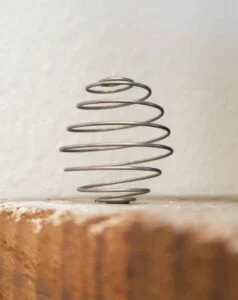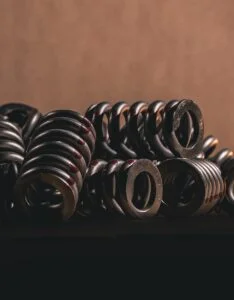
Does your part require a spring that compresses with applied force? If so, you probably need a compression spring.
A standard, cylindrical compression spring might do the trick. These springs are ideal for most conventional applications requiring a constant spring rate.
But suppose you need a compression spring that provides more structural support, like one that can prevent a hose from kinking when coiled. In that case, you might need a less common type of compression spring.
The good news is you have a wide range of options to choose from. A custom compression spring manufacturer like Gifford Spring can help you make the right selection for your application.
3 Compression Spring Styles You Might Not Know About
These 3 types of compression springs offer unique benefits that might suit your application better than a standard cylindrical compression spring:
- Conical Spring
- Hourglass Spring
- Barrel Spring
Conical compression spring. These cone-shaped compression springs coil in increasing or decreasing outer diameters. Unlike a cylindrical compression spring, a conical spring does not provide a constant spring rate, allowing for specific loads to be achieved at specific compressed lengths.
Conical compression springs can collapse to a completely flat shape. This feature is useful for spring applications requiring a small solid height, like battery contacts or push buttons.
Hourglass compression spring. Also known as concave springs, hourglass compression springs have large diameter end coils and smaller diameter middle coils that create their signature shape. Hourglass compression springs behave almost as two conical springs pressed end to end, also allowing for a low profile when compressed to solid height.
While an uncommon style, an hourglass spring is often chosen to fit within a specific hole size or to prevent buckling.
Barrel compression spring. These convex springs have wider coils in the center than on the ends, making them sturdier than cylindrical springs. Like hourglass compression springs, they typically won’t buckle when compressed.
Unlike conical springs that can easily collapse, barrel compression springs require much more force to compress and don’t easily compress to solid height. Many barrel springs are not used for their spring properties, and instead are used as a handle to provide comfortable grip or heat resistance with a hot object.
Compression Spring Considerations
Here are several key factors to consider when selecting a compression spring:
- Variable Pitch
- Dead Coils
- Open Ends
- Ground ends
- Variable pitch. The distance between each coil—known as the pitch—directly affects the spring rate. Most compression springs have a constant pitch and spring rate, but some designs will require a variable pitch to provide a non-constant spring rate. It’s important to select a spring that provides the right spring rate for your application.
- Dead coils. To increase the length of a spring while maintaining spring rate and travel length, you may choose to add dead coils—adjacent coils with no spacing when the spring is at its maximum loaded height. When compressed, these coils are inactive and do not affect the active coils of the spring.
- Closed vs. open ends. Nearly all compression springs are closed on either end to sit flat. However, in rare instances, certain applications may need open-ended springs that require support from a rod or tube to stand upright. Open springs do not offer a flat surface to compress against and tend to tangle, so they’re uncommon in most applications.
- Ground ends. Grinding the ends of a compression spring on a grinding wheel is a great way to achieve an even flatter surface. Finished ends increase stability and allow for maximum contact surface area.
Not sure which type of spring you need? Talk through your options with a custom compression spring manufacturer. Consult the specialists at Gifford Spring today!






